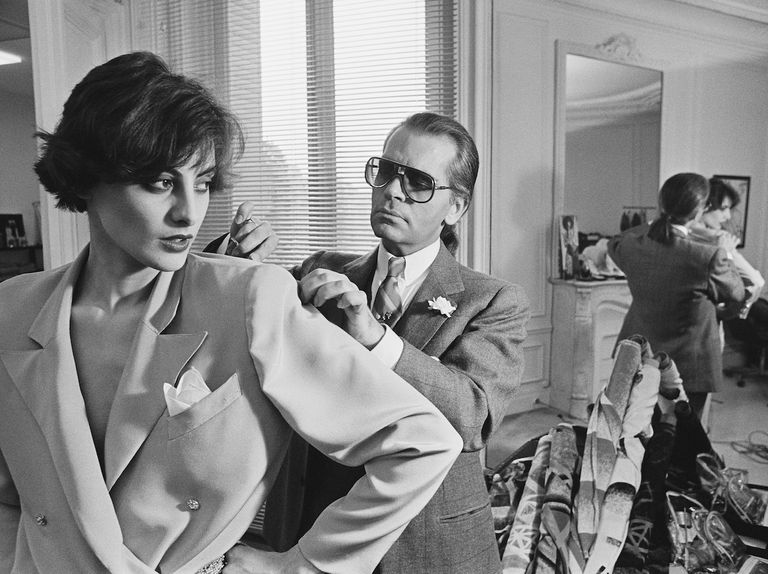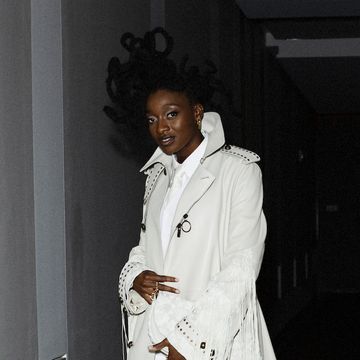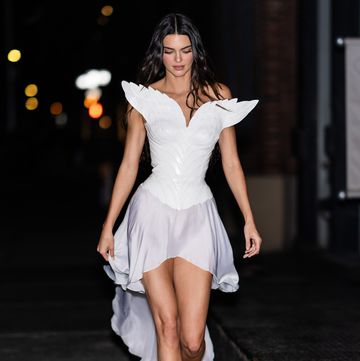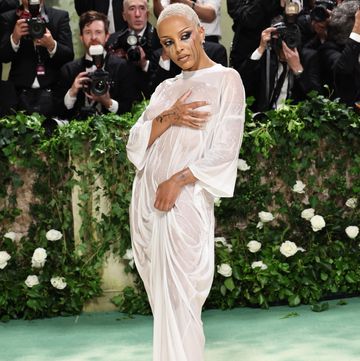As the creative director of Chanel since 1983 and Fendi since 1965, the German-born, Paris-based, ivory-ponytailed titan Karl Lagerfeld was one of the couture world’s last great living masters.
A black leather-clad link to fashion’s storied history — and the creator of the fast-paced, ever- changing fashion system that would alter the course of the industry’s future.
Fashion has long thrived on disruption. Like the to-the-calendar rotation of trends, the coming and going of designers, supermodels, looks, front-row personalities and talking points (moods and moments, if you will) are the gilded gears and sprockets that keep the business moving. The only constant is change and all that.
And the constant change keeps things interesting, people talking, journalists writing, consumers buying. But the death of Karl Lagerfeld in February, a passing the industry is collectively still coming to terms with months later, feels like significantly more than a fleeting moment or changing tide.
Instead, his death left many mourning the end of an era.
The first time I sat down with Karl in his private office on Paris’ Left Bank, seven years ago, I was struck by how the then 78-year-old man seemed to be the living embodiment of the ‘move fast’ maxims touted by the Facebooks of the world, all while those half his age seemed to struggle to keep up with the demands of being a modern-day creative director.
As I waited for him to arrive, his team offered me a Magnum ice-cream (a brand for which he directed commercials) and a bottle of Diet Coke emblazoned with a miniature Lagerfeld, designed by the man himself.
I drank the soda out of a sleek, cube-shaped Orrefors glass created by, you guessed it, and thumbed through the biographies of Dalí, Chagall, and Duchamp in his famously extensive library of more than 300,000 books.
He designed 14 collections that year for Chanel and Fendi alone.
That number doesn’t include all the work he created for his own signature 'masstige' line, Karl Lagerfeld. And throughout the dizzying output, he had a persistent drive to move forward.
'I might look the part. But I’m not that human, hmm?' he told me in his trademark mile-a-minute speed with humour when we discussed his otherworldly productivity (Karl spoke four languages: German, French, Italian and English).
Long before Virgil Abloh told ELLE that 'the only way to be relevant is to be this new genre of fashion designer, where it’s not just about the garment but the branding and principles', Karl had done it. More than 44 years before, to be exact.
That was back when he told Women’s Wear Daily, 'When people ask me what I do, 'designer' seems inadequate; I tell them I’m in the fashion business. But that is what happens with ready-to-wear. You become an enterprise.'
Because of it, he became one of the few designers to become a household name.
‘I first became aware of Karl when he took over at Chanel. As a fashion-obsessed teenager, my reference points before that were gleaned from the style titles, music and the fantasy images in Vogue (ELLE had not launched in the UK at that point),' ELLE’s former editor-in-chief Anne-Marie Curtis recalls.
'I remember seeing pictures of that first show in Paris and just wanting to wear the clothes. It was the first time I really connected with a high fashion brand in that way.'
And while most of his contemporaries – Yves Saint Laurent, Valentino Garavani and Azzedine Alaïa to name a few – had revisited their extensive archives through sprawling retrospective exhibitions, Karl resisted any invitations to look backward.
'I’m not a vintage specialist,' he told me during a later interview.
'Not for my life, not for my work, for nothing. I have no archives. Maybe the houses keep archives. I have nothing. I’m not interested in what I did. I’m just interested in what I’m doing, what can be inspired.’
In many ways, Karl and ELLE were kindred spirits: the two came of age together.
Born around ten years before ELLE France was founded in 1945, both shared a boldly future-facing ethos, a special affinity for the new and heightened sensitivity to the zeitgeist, and an unapologetic knack for mixing the high and low.
On the one hand, he was the undisputed king of the luxury fashion world.
There were his decades building Chanel into a nearly $10 billion business through his prolific re-imaginings of the iconic house codes (a pearl-encrusted denim dress one season, a futuristic plastic tweed hybrid suit another); half a century redefining the visual vocabulary of Fendi (his recent revival of logo-mania saw families Hadid and Kardashian, babies and all, clad in the brand’s interlocking Fs); and off-and-on-again relationship with Chloé during the Sixties, Seventies and Nineties (romantic, loose blouses and flowing dresses dripping with insouciance, often photographed by Guy Bourdin in legendary ad campaigns).
'My dresses are for women who go beyond the obvious. It’s why I strung them together with belts of strings and espadrilles. They’re made to transform everyday life into a fairy tale, to create an atmosphere at every moment,' he told Women’s Wear Daily during his time at Chloé.
But Karl was also the man who introduced the fairy tale, the world of high fashion, to the masses. When he partnered with H&M in 2004 to create the brand’s first designer collection, its success opened the floodgates to high-low collaborations across the fashion ecosystem.
'When I did H&M, I had a kind of appeal for people who buy inexpensive. I don’t say 'cheap', because people are cheap. But clothes are not supposed to be cheap – they are supposed to be well designed and not expensive. There’s a very big difference. When I did H&M, everyone said, 'Don’t do it.' And it worked. When I took over Chanel, everyone said to me, 'Don’t do it, it’s dead, it doesn’t work.' It worked beyond. So, I better not listen to people and follow only my instincts,' he told me.
His instincts were legendary.
Karl had unusually sharp antennae, a built-in weather predictor for the coming winds of change. Before runway productions became these highly immersive Instagrammable experiences – before Instagram existed, even – Karl produced fantastical catwalk sets inside Paris’ historic Grand Palais.
'They all transported you to another universe with a real sense of theatre, humour and a feeling you were utterly in 'Karl’s world',' Curtis recalls.
'I remember the Métiers d’Art show in Hamburg last year. It was very moving, as if Karl was 'coming home'. The after-party was a recreation of a traditional German bierkeller with Karl sitting on a bench at one of the low wooden tables, mingling with the guests and just being Karl.'
There were icebergs flown in from Scandinavia, a life-sized rocket ship that launched with smoke and flames, an elaborate supermarket filled with Chanel-branded produce, a high-fashion casino with poker tables, a barn filled with hay and a raging women’s rights protest.
Ah, the protest. It was SS15 – two years before Dior sold a T-shirt emblazoned with the Chimamanda Ngozi Adichie essay title, 'We Should All Be Feminists', and three years before #MeToo went mainstream.
Before the conversation around women’s rights took on a new sense of urgency, Karl staged a demonstration of his own on the Chanel runway. With placards that read 'Women’s Rights Are More Than Alright!' and 'History Is Her Story', the blowback was swift.
Nevertheless, Karl gravitated towards strong-minded women with an equally strong sense of self and style: everyone from muses Amanda Harlech and Inès de la Fressange to Rihanna, Florence Welch, Julianne Moore, Cara Delevingne, Willow Smith and Azealia Banks.
'Karl makes me feel anything is possible. He’s had a massive impact on how I am viewed by the fashion world and his friendship and support has been invaluable,' Welch – who performed at his SS12 Chanel show – told ELLE.
For better or worse, Karl epitomised the hashtag #NoFilter.
He spoke in quotable, Twitter-length sound bites that could incite uproarious laughter or scandal, whether he was panning sweatpants ('a sign of defeat') or making self-deprecating proclamations ('When I was younger I wanted to be a caricaturist. In the end, I’ve become a caricature').
He was not a man who minced words, even when considering his own mortality.
When I asked him if he was afraid of death, his answer was typically Karl, with quick-fire humour:
'[Poet Percy Bysshe] Shelley said, 'Death may be a waking up from the dream of life.' But, if you ask me, I think it’s like a sleep where you don’t wake up. You don’t remember before, you don’t remember after. The only thing is, I don’t want to be seen dead. So anyway, over, over. The battery is finished, huh, puft.'
This article appears in the May 2019 edition of ELLE UK. Subscribe here to make sure you never miss an issue.


















